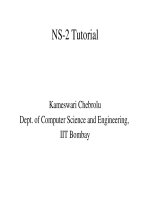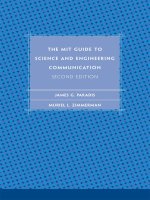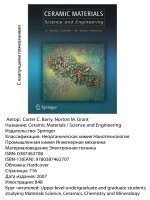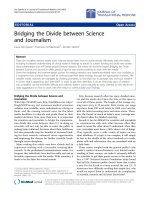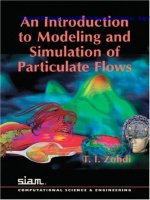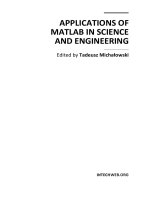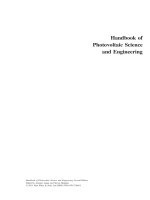Computational Science and Engineering potx
Bạn đang xem bản rút gọn của tài liệu. Xem và tải ngay bản đầy đủ của tài liệu tại đây (14.75 MB, 195 trang )
Simpo PDF Merge and Split Unregistered Version -
An Introduction
to Modeling and
Simulation of
Particulate Flows
cs04_ZohdiFM-a.qxp 5/17/2007 1:44 PM Page 1
Simpo PDF Merge and Split Unregistered Version -
Computational Science and Engineering (CS&E) is widely accepted, along with theory and experiment, as
a crucial third mode of scientific investigation and engineering design. This series publishes research
monographs, advanced undergraduate- and graduate-level textbooks, and other volumes of interest to
a wide segment of the community of computational scientists and engineers. The series also includes
volumes addressed to users of CS&E methods by targeting specific groups of professionals whose work
relies extensively on computational science and engineering.
Editor-in-Chief
Omar Ghattas
University of Texas at Austin
Editorial Board
COMPUTATIONAL SCIENCE & ENGINEERING
David Keyes, Associate Editor
Columbia University
Ted Belytschko
Northwestern University
Clint Dawson
University of Texas at Austin
Lori Freitag Diachin
Lawrence Livermore National Laboratory
Charbel Farhat
Stanford University
James Glimm
Stony Brook University
Teresa Head-Gordon
University of California–Berkeley and
Lawrence Berkeley National Laboratory
Rolf Jeltsch
ETH Zurich
Chris Johnson
University of Utah
Laxmikant Kale
University of Illinois
Efthimios Kaxiras
Harvard University
Jelena Kovacevic
Carnegie Mellon University
Habib Najm
Sandia National Laboratory
Alex Pothen
Old Dominion University
Series Volumes
Zohdi,T. I., An Introduction to Modeling and Simulation of Particulate Flows
Biegler, Lorenz T., Omar Ghattas, Matthias Heinkenschloss, David Keyes, and Bart van Bloemen Waanders,
Editors, Real-Time PDE-Constrained Optimization
Chen, Zhangxin, Guanren Huan, and Yuanle Ma, Computational Methods for Multiphase Flows in Porous Media
Shapira,Yair, Solving PDEs in C++: Numerical Methods in a Unified Object-Oriented Approach
cs04_ZohdiFM-a.qxp 5/17/2007 1:44 PM Page 2
Simpo PDF Merge and Split Unregistered Version -
An Introduction
to Modeling and
Simulation of
Particulate Flows
T. I. Zohdi
University of California–Berkeley
Berkeley, California
Society for Industrial and Applied Mathematics
Philadelphia
cs04_ZohdiFM-a.qxp 5/17/2007 1:44 PM Page 3
Simpo PDF Merge and Split Unregistered Version -
Copyright © 2007 by the Society for Industrial and Applied Mathematics.
10 9 8 7 6 5 4 3 2 1
All rights reserved. Printed in the United States of America. No part of this book may be reproduced,
stored, or transmitted in any manner without the written permission of the publisher. For information,
write to the Society for Industrial and Applied Mathematics, 3600 University City Science Center,
Philadelphia, PA 19104-2688.
Trademarked names may be used in this book without the inclusion of a trademark symbol.These names
are used in an editorial context only; no infringement of trademark is intended.
Figures 2.1–2.4, 4.1–4.3, 5.2, and 5.3 are reprinted with permission from Zohdi,T.I., 2004, Modeling and
direct simulation of near-field granular flows, The International Journal of Solids and Structures,Vol. 42,
issue 2, pp. 539–564. Copyright © 2004 by Elsevier Ltd.
Figures 6.1–6.6 are reprinted with permission from Zohdi,T.I., 2003, Computational design of swarms,
The International Journal of Numerical Methods in Engineering,Vol. 57, pp. 2205–2219. Copyright © 2003
John Wiley & Sons Ltd.
Figures 7.1, 7.2, and 7.4–7.11 are reprinted with permission from Zohdi,T.I., 2005, Charge-induced
clustering in multifield granular flow, The International Journal of Numerical Methods in Engineering,Vol. 62,
issue 7, pp. 870–898. Copyright © 2004 John Wiley & Sons Ltd.
Figures 8.1–8.6 are reprinted with permission from Zohdi,T.I., in press, Computation of strongly coupled
multifield interaction in particle-fluid systems, Computer Methods in Applied Mechanics and Engineering.
Copyright © Elsevier Ltd.
Figures 9.1, 9.2, 9.4, 9.7, and 9.11–9.18 are reprinted with permission from Zohdi,T.I., 2006, Computation
of the coupled thermo-optical scattering properties of random particulate systems, Computer Methods in
Applied Mechanics and Engineering,Vol. 195, issues 41–43, pp. 5813–5830. Copyright © 2005 Elsevier Ltd.
Figures 9.5, 9.6, 9.8–9.10, B.3, and B.4 are reprinted with permission from Zohdi,T.I., 2006, On the optical
thickness of disordered particulate media, Mechanics of Materials,Vol. 38, pp. 969–981. Copyright © 2005
Elsevier Ltd.
Figures B.5–B.9 are reprinted with permission from Zohdi,T.I. and Kuypers, F.A., 2006, Modeling and rapid
simulation of multiple red blood cell light scattering, Journal of the Royal Society Interface,Vol. 3, no. 11, pp.
823–831. Copyright © 2006 The Royal Society of London.
The cover was produced from images created by and used with permission of the Scientific Computing
and Imaging (SCI) Institute, University of Utah; J. Bielak, D. O’Hallaron, L. Ramirez-Guzman, and T.Tu,
Carnegie Mellon University; O. Ghattas, University of Texas at Austin; K. Ma and H.Yu, University of
California, Davis; and Mark R. Petersen, Los Alamos National Laboratory. More information about the
images is available at />Library of Congress Cataloging-in-Publication Data
Zohdi,Tarek I.
An introduction to modeling and simulation of particulate flows / Tarek I. Zohdi.
p. cm. (Computational science and engineering)
ISBN 978-0-898716-27-6 (alk. paper)
1. Granular materials Fluid dynamics Mathematical models. I.Title.
TA418.78.Z64 2007
620’.43 dc22
2007061728
is a registered trademark.
cs04_ZohdiFM-a.qxp 5/17/2007 1:44 PM Page 4
Simpo PDF Merge and Split Unregistered Version -
Dedicated to my patient wife, Britta,
and my mother and father, Omnia and Magd
cs04_ZohdiFM-a.qxp 5/17/2007 1:44 PM Page 5
Simpo PDF Merge and Split Unregistered Version -
cs04_ZohdiFM-a.qxp 5/17/2007 1:44 PM Page 6
Simpo PDF Merge and Split Unregistered Version -
05 book
2007/5/15
page vii
✐
✐
✐
✐
✐
✐
✐
✐
Contents
List of Figures xi
Preface xv
1 Fundamentals 1
1.1 Notation 1
1.2 Kinematics of a single particle 2
1.3 Kinetics of a single particle 3
1.3.1 Work, energy, and power 3
1.3.2 Properties of a potential 4
1.3.3 Impulse and momentum 5
1.4 Systems of particles 6
1.4.1 Linear momentum 6
1.4.2 Energy principles 7
1.4.3 Remarks on scaling 8
2 Modeling of particulate flows 11
2.1 Particulate flow in the presence of near-fields 11
2.2 Mechanical contact with near-field interaction 12
2.3 Kinetic energy dissipation 15
2.4 Incorporating friction 17
2.4.1 Limitations on friction coefficients 18
2.4.2 Velocity-dependent coefficients of restitution 19
3 Iterative solution schemes 21
3.1 Simple temporal discretization 21
3.2 An example of stability limitations 22
3.3 Application to particulate flows 22
3.4 Algorithmic implementation 26
4 Representative numerical simulations 31
4.1 Simulation parameters 32
4.2 Results and observations 33
vii
Simpo PDF Merge and Split Unregistered Version -
05 book
2007/5/15
page viii
✐
✐
✐
✐
✐
✐
✐
✐
viii Contents
5 Inverse problems/parameter identification 39
5.1 A genetic algorithm 40
5.2 A representative example 43
6 Extensions to “swarm-like” systems 47
6.1 Basic constructions 48
6.2 A model objective function 49
6.3 Numerical simulation 50
6.4 Discussion 52
7 Advanced particulate flow models 55
7.1 Introduction 55
7.2 Clustering and agglomeration via binding forces 55
7.3 Long-range instabilities and interaction truncation 56
7.4 A simple model for thermochemical coupling 58
7.4.1 Stage I: An energy balance during impact 59
7.4.2 Stage II: Postcollision thermal behavior 61
7.5 Staggering schemes 63
7.5.1 A general iterative framework 63
7.5.2 Semi-analytical examples 66
7.5.3 Numerical examples involving particulate flows 68
8 Coupled particle/fluid interaction 81
8.1 A model problem 82
8.1.1 A simple characterization of particle/fluid interaction . . . 82
8.1.2 Particle thermodynamics 84
8.2 Numerical discretization of the Navier–Stokes equations 86
8.3 Numerical discretization of the particle equations 89
8.4 An adaptive staggering solution scheme 91
8.5 A numerical example 95
8.6 Discussion of the results 98
8.7 Summary 101
9 Simple optical scattering methods for particulate media 103
9.1 Introduction 104
9.1.1 Ray theory: Scope of use 104
9.1.2 Beams composed of multiple rays 105
9.1.3 Objectives 106
9.2 Plane harmonic electromagnetic waves 107
9.2.1 Plane waves 107
9.2.2 Electromagnetic waves 107
9.2.3 Optical energy propagation 108
9.2.4 Reflection and absorption of energy 109
9.3 Multiple scatterers 113
9.3.1 Parametrization of the scatterers 114
9.3.2 Results for spherical scatterers 116
9.3.3 Shape effects: Ellipsoidal geometries 118
Simpo PDF Merge and Split Unregistered Version -
05 book
2007/5/15
page ix
✐
✐
✐
✐
✐
✐
✐
✐
Contents ix
9.4 Discussion 119
9.5 Thermal coupling 120
9.6 Solution procedure 122
9.7 Inverse problems/parameter identification 124
9.8 Parametrization and a genetic algorithm 125
9.9 Summary 128
10 Closing remarks 133
A Basic (continuum) fluid mechanics 137
A.1 Deformation of line elements 137
A.2 The Jacobian of the deformation gradient 138
A.3 Equilibrium/kinetics of solid continua 138
A.4 Postulates on volume and surface quantities 139
A.5 Balance law formulations 140
A.6 Symmetry of the stress tensor 140
A.7 The first law of thermodynamics 141
A.8 Basic constitutive assumptions for fluid mechanics 142
B Scattering 145
B.1 Generalized Fresnel relations 145
B.2 Biological applications: Multiple red blood cell light scattering 145
B.2.1 Parametrization of cell configurations 148
B.2.2 Computational algorithm 148
B.2.3 A computational example 149
B.2.4 Extensions and concluding remarks 153
B.3 Acoustical scattering 155
B.3.1 Basic relations 155
B.3.2 Reflection and ray-tracing 156
Bibliography 159
Index 175
Simpo PDF Merge and Split Unregistered Version -
05 book
2007/5/15
page x
✐
✐
✐
✐
✐
✐
✐
✐
Simpo PDF Merge and Split Unregistered Version -
05 book
2007/5/15
page xi
✐
✐
✐
✐
✐
✐
✐
✐
List of Figures
2.1 Compression and recovery of two impacting particles (Zohdi [212]). . . . 12
2.2 Two identical particles approaching one another (Zohdi [212]). 15
2.3 Two identical particles approaching one another (Zohdi [212]). 18
2.4 Qualitative behavior of the coefficient of restitution with impact velocity
(Zohdi [212]). 20
4.1 A typical starting configuration for the types of particulate systems under
consideration. 33
4.2 The proportions of the kinetic energy that are bulk and relative motion for
e
o
= 0.5, µ
s
= 0.2, µ
d
= 0.1: (1) no near-field interaction, (2) α
1
= 0.1
and
α
2
= 0.05, (3) α
1
= 0.25 and α
2
= 0.125, and (4) α
1
= 0.5 and
α
2
= 0.25 (Zohdi [212]). 33
4.3 The total kinetic energy in the system per unit mass for e
o
= 0.5, µ
s
=
0.2, µ
d
= 0.1: (1) no near-field interaction, (2) α
1
= 0.1 and α
2
= 0.05,
(3)
α
1
= 0.25 and α
2
= 0.125, and (4) α
1
= 0.5 and α
2
= 0.25 (Zohdi
[212]). 34
5.1 A typical cost function. 41
5.2 The best parameter set’s (
α
1
, α
2
,β
1
,β
2
) objective function value with
passing generations (Zohdi [212]). 44
5.3 Simulation results using the best parameter set’s (
α
1
, α
2
,β
1
,β
2
) values
(for one random realization (Zohdi [212])). 44
6.1 Interaction between the various components (Zohdi [209]). 48
6.2 The initial setup for a swarm example (Zohdi [209]). 50
6.3 Generational values of the best design’s objective function and the aver-
age of the best six designs’objective functions for various swarm member
sizes (Zohdi [209]). 50
6.4 The swarm (128 swarm members) bunches up and moves through the
obstacle fence, under thecenterobstacle, unharmed (centered at (5, 0, 0)),
and then unpacks itself (Zohdi [209]). 52
6.5 The swarm then goes through and slightly overshoots the target (10, 0, 0),
and then undershoots it slightly and starts to concentrate itself (Zohdi [209]). 53
xi
Simpo PDF Merge and Split Unregistered Version -
05 book
2007/5/15
page xii
✐
✐
✐
✐
✐
✐
✐
✐
xii List of Figures
6.6 The swarm starts to oscillate slightly around the target and then begins
to home in on the target and concentrate itself at (10, 0, 0) (Zohdi [209]). 54
7.1 Clustering within a particulate flow (Zohdi [217]). 56
7.2 Identification of an inflection point (loss of convexity (Zohdi [217])). . . 57
7.3 Introduction of a cutoff function. 58
7.4 Presence of dilute (smaller-scale) reactive gas particles adsorbed onto the
surface of two impacting particles (Zohdi [217]). 59
7.5 The dynamics of the particulate flow with clustering forces: An initially
fine cloud of particles that clusters to form structures within the flow. Blue
indicates a temperature of approximately 300
◦
K, while red indicates a
temperature of approximately 400
◦
K (Zohdi [217]). 69
7.6 The dynamics of the particulate flow without clustering forces. Blue
indicates a temperature of approximately 300
◦
K, while red indicates a
temperature of approximately 400
◦
K (Zohdi [217]) 70
7.7 With clustering forces: the total kinetic energy in the system per unit
mass with e
o
= 0.5, µ
s
= 0.2, µ
d
= 0.1, α
1
= 0.5, and α
2
= 0.25rm :
(1) κ = 10
6
J/m
2
, (2) κ = 2 × 10
6
J/m
2
, (3) κ = 4 × 10
6
J/m
2
, and (4)
κ = 8 × 10
6
J/m
2
(Zohdi [217]). 71
7.8 Without clustering forces: the total kinetic energy in the system per unit
mass with e
o
= 0.5, µ
s
= 0.2, µ
d
= 0.1, α
1
= 0.5, and α
2
= 0.25:
(1) κ = 10
6
J/m
2
, (2) κ = 2 × 10
6
J/m
2
, (3) κ = 4 × 10
6
J/m
2
, and (4)
κ = 8 × 10
6
J/m
2
(Zohdi [217]). 72
7.9 With clustering forces: the average particle temperature with e
o
= 0.5,
µ
s
= 0.2, µ
d
= 0.1, α
1
= 0.5, and α
2
= 0.25: (1) κ = 10
6
J/m
2
, (2)
κ = 2×10
6
J/m
2
, (3) κ = 4×10
6
J/m
2
, and (4) κ = 8×10
6
J/m
2
(Zohdi
[217]). 73
7.10 Without clustering forces: the average particle temperature with e
o
= 0.5,
µ
s
= 0.2, µ
d
= 0.1, α
1
= 0.5, and α
2
= 0.25: (1) κ = 10
6
J/m
2
, (2)
κ = 2×10
6
J/m
2
, (3) κ = 4×10
6
J/m
2
, and (4) κ = 8×10
6
J/m
2
(Zohdi
[217]). 74
7.11 A zoom on the structures that form with clustering. Blue indicates a
temperature of approximately 300
◦
K, while red indicates a temperature
of approximately 400
◦
K (Zohdi [217]). 75
7.12 Cases with and without charging. 75
7.13 A charged cloud against an immovable obstacle. 76
7.14 The maximum force (and corresponding friction force) versus time im-
parted on the immovable obstacle surface, max(
I), with and without
charging. Notice that the maximum “signature” force is less with charging. 77
7.15 The total force (and corresponding friction force) versus time imparted
on the immovable obstacle surface, max(
I), with and without charging.
Notice that the total “signature” force is less with charging. 78
7.16 Slow impact of charged clouds. The clouds combine into a larger cloud. . 79
7.17 Fast impact of charged clouds. The clouds disperse. 80
8.1 Decomposition of the fluid/particle interaction (Zohdi [224]). 82
Simpo PDF Merge and Split Unregistered Version -
05 book
2007/5/15
page xiii
✐
✐
✐
✐
✐
✐
✐
✐
List of Figures xiii
8.2 A representative volume element extracted from a flow (Zohdi [224]). . . 96
8.3 With near-fields: the dynamics of the particulate flow. Blue (lowest)
indicates a temperature of approximately 300
◦
K, while red (highest)
indicates a temperature of approximately 600
◦
K. The arrows on the
particles indicate the velocity vectors (Zohdi [224]). 99
8.4 With near-fields: The average velocity and temperature of the particles
(Zohdi [224]). 100
8.5 Without near-fields: The average velocity and temperature of the particles
(Zohdi [224]). 100
8.6 The time step size variation. With and without near-fields (Zohdi [224]). 100
9.1 The multiparticle scattering system considered, comprised of a beam
made up of multiple rays, incident on a collection of randomly distributed
scatterers (Zohdi [218]). 105
9.2 A wave front and propagation vector (Zohdi [218]). 106
9.3 Thescattering system considered, comprising a beam made up of multiple
rays, incident on a collection of randomly distributed scatterers. 109
9.4 The nomenclature for Fresnel’s equations, for the case where the electric
field vectors are perpendicular to the plane of incidence and parallel to
the plane of incidence (Zohdi [218]). 109
9.5 The nomenclature for Fresnel’s equations for a incident ray that encoun-
ters a scattering particle (Zohdi [219]). 113
9.6 The progressive movement of rays making up a beam (L = 0.325 and
ˆn = 10). The lengths of the vectors indicate the irradiance (Zohdi [219]). 115
9.7 The variation of as a function of L (Zohdi [218]). 117
9.8 Asinglescatterer, and the integrated reflectance (I) over a quarter of a sin-
gle scatterer, which indicates the total fraction of the irradiance reflected
(Zohdi [219]). 118
9.9 (Oblate) Ellipsoids of aspect ratio 4:1: The variation of as a function
of L. The volume fraction is given by v
p
=
πL
3
4
(Zohdi [219]). 118
9.10 Results for acoustical scattering (ˆc = 1/ ˜c) (Zohdi [219]). 120
9.11 Control volume for heat transfer (Zohdi [218]). 122
9.12 Definition of a particle length scale (Zohdi [218]). 126
9.13 The best parameter set’s objective function values for successive gener-
ations. Note: The first data point in the optimization corresponds to the
objective function’s value for mean parameter values of upper and lower
bounds of the search intervals (Zohdi [218]). 126
9.14 The progressive movement of rays making up a beam (for the best inverse
parameter set vector (Table 9.2)). The colors of the particles indicate
their temperature and the lengths of the vectors indicate the irradiance
magnitude (Zohdi [218]). 127
9.15 Continuing Figure 9.14, the progressive movement of rays making up a
beam (for the best inverse parameter set vector (Table 9.2)). The colors
of the particles indicate their temperature and the lengths of the vectors
indicate the irradiance magnitude (Zohdi [218]). 129
Simpo PDF Merge and Split Unregistered Version -
05 book
2007/5/15
page xiv
✐
✐
✐
✐
✐
✐
✐
✐
xiv List of Figures
9.16 The components of the average position over time for the best parameter
set, and the components of the average ray velocity and the Euclidean
norm over time for the best parameter set. The normalized quantity
||v||/c = 1 serves as a type of computational “error check” (Zohdi [218]). 130
9.17 The components of the average ray irradiance and the Euclidean norm
over time for the best parameter set, and the average temperature of the
scatterers over time for the best parameter set (Zohdi [218]). 131
9.18 The average thermal radiation of the scatterers over time for the best
parameter set (Zohdi [218]). 131
A.1 Cauchy tetrahedron: A “sectioned material point.” 139
B.1 The variation of the reflectance, R, with angle of incidence. For all but
ˆn = 2, there is discernible nonmonotone behavior. The behavior is slight
for ˆn = 4, but nonetheless present (Zohdi [219]). 146
B.2 The variation of the reflectance, R, with angle of incidence for ˆµ = 2
and ˆµ = 10 (Zohdi [219]). 146
B.3 The scattering system considered, comprising a beam, made up of multi-
ple rays, incident on a collection of randomly distributed RBCs; a typical
RBC (Zohdi and Kuypers [223]). 147
B.4 The nomenclature for Fresnel’s equations for an incident ray that encoun-
ters a scattering cell (Zohdi and Kuypers [223]). 148
B.5 Theprogressive movement of rays (1000) making up a beam (ˆn = 1.075).
The lengths of the vectors indicate the irradiance (Zohdi and Kuypers
[223]). The diameter (8000 cells) of the scatterers is given by Equation
(B.2). 150
B.6 Computational results for the propagation of the forward scatter of I
x
(t)/
||I(0)||for increasingly larger numbers of cells in the sample (Zohdi and
Kuypers [223]). 151
B.7 A comparison between the computational predictions and laboratory re-
sults for 710-nm and 420-nm light (four trials each, Zohdi and Kuypers
[223]). 152
B.8 A local coordinate system for a ray reflection. 157
Simpo PDF Merge and Split Unregistered Version -
05 book
2007/5/15
page xv
✐
✐
✐
✐
✐
✐
✐
✐
Preface
The study of “granular” or “particulate” media is wide ranging. Classical examples
include the study of natural materials, such as sand and gravel, associated with coastal
erosion, landslides, and avalanches. A concise introduction is given by Duran [61]. Many
manufactured materials also fall within this class of problems.
1
For general overviews of
granular media, we refer the reader to Jaeger and Nagel [100], [101], Nagel [151], Liu et al.
[139], Liu and Nagel [140], Jaeger and Nagel [102], Jaeger et al. [103]–[105], and Jaeger
and Nagel [106]; the extensive works of Hutter and collaborators: Tai et al. [188]–[190],
Gray et al. [80], Wieland et al. [201], Berezin et al. [28], Gray and Hutter [81], Gray [82],
Hutter [96], Hutter et al. [97], Hutter and Rajagopal [98], Koch et al. [126], Greve and
Hutter [85], and Hutter et al. [99]; the works of Behringer and collaborators: Behringer
[22], Behringer and Baxter [21], Behringer and Miller [23], and Behringer et al. [24]; the
works of Jenkins and collaborators: Jenkins and Strack [107], Jenkins and La Ragione
[108], Jenkins and Koenders [109], and Jenkins et al. [110]; and the works of Torquato
and collaborators: Torquato [194], Kansaal et al. [119], and Donev et al. [55]–[59]. In
this monograph, we focus on a subset of the very large field of granular materials, namely,
fluidized (lower-density) particulate flows.
2
Recently, several modern applications, primarily driven by microtechnology, have
emerged where a successful analysis requires the simulation of flowing particulate media
involving simultaneous near-field interaction between charged particles and momentum ex-
change through mechanical contact.
3
For example, in many systems containing flowing
particles below the one millimeter scale, the particles can acquire relatively large elec-
trostatic charges, leading to significant interparticle near-field forces. In some cases, the
1
Over half (by weight) of the raw materials handled in chemical industries appear in granulated or particulate
form. The resulting structural properties of solid products which originate as granulated or particulate media, and
which are transported and constructed using flow processes, are outside the scope of this monograph. For more
details, see, for example, Aboudi [1], Hashin [90], Mura [150], Nemat-Nasser and Hori [152], Torquato [194], and
Zohdi and Wriggers [216].
2
It is worth noting that fast computational methods, in particular efficient contact search techniques, for the
treatment of densely packed granular or particulate media, in the absence of near-field forces, can be found in the
recent work of Pöschel and Schwager [167]. Such techniques are outside the scope of the present work, but they
are relatively easy to implement.
3
For example, industrial processes such as chemical mechanical planarization (CMP), which involves using
chemically reactingparticlesembedded in fluid(gasor liquid) toablaterough small-scale surfacesflat,havebecome
important in the success of many micro- and nanotechnologies. For a review of CMP practice and applications,
see Luo and Dornfeld [143]–[146].
xv
Simpo PDF Merge and Split Unregistered Version -
05 book
2007/5/15
page xvi
✐
✐
✐
✐
✐
✐
✐
✐
xvi Preface
near-field forces could be due to magnetic effects, or they could be purposely induced.
4
Charged material can lead to inconsistent “clean” manufacturing processes, for example,
due to difficulties with dust control, although intentional charging of particulate material can
be quite useful in some applications, for example, in electrostatic copiers, inkjet printers,
and powder coating machines. The presence of near-field interaction forces can produce
particulate flows that are significantly different from purely contact-driven scenarios. De-
termining the dynamics of such materials is important in accurately describing the flow of
powders, which form the basis of microfabrication. Near-field forces can lead to particle
clustering, resulting in inconsistent fabrication quality. Therefore, neglecting such near-
field effects can lead to a gross miscalculation of the characteristics of such flows.
5
Thus,
an issue of overriding importance to the successful characterization of such flows is the
development of models and reliable computational techniques to simulate the dynamics of
multibody particulate systems involving near-field interaction and contact simultaneously
(including thermal effects). This is the primary focus of this monograph.
A central objective of this work is to provide basic models and numerical solution
strategies for the direct simulation of flowing particulate media that can be achieved within a
relatively standard desktop or laptop computing environment. A primary assumption is that
the objects in the flow are considered to be small enough to be idealized as particles and that
the effects of their rotation with respect to their mass centers is unimportant to their overall
motion.
6
Our primary concern is with particulate media that are “fluidized,” i.e., they are
not densely packed together. Oftentimes, such media are referred to as “granular gases.” In
particular, the initial chapters of the monograph are dedicated to so-called dry particulate
flows, where there is no significant interstitial fluid. However, while this monograph focuses
almost exclusively on the dry problem, Chapter 8 gives an introduction to strongly coupled
(surrounding) fluid/particle interaction scenarios. Also, an introduction to computational
optical techniques for particulate media is provided. Simulations described in upcoming
chapters can be found at />Ideally, in an attempt to reduce laboratory expenses, one would like to make predic-
tions of a complex particulate flow’s behavior by numerical simulations, with the primary
goal being to minimize time-consuming trial and error experiments. The recent dramatic
increase in computational power available for mathematical modeling and simulation raises
the possibility that modern numerical methods can play a significant role in the analysis
of complex particulate flows. This fact has motivated the work presented in this mono-
graph. This work can be viewed as a research monograph, suitable for use in a first-year
graduate course for students in the applied sciences, engineering, and applied mathemat-
4
For many engineering materials, some surface adhesion persists even when no explicit charging has occurred.
For example, see Tabor [186] or Johnson [111].
5
For example, on the atomic scale, forces of attraction can arise from a temporary dipole created by fluctuating
electron distributions around an atom. This will induce a dipole on a neighboring atom, and if the induced dipole is
directed in the same way as the first atom, the two molecules associated with these atoms will attract one another.
Between two atoms, such a force acts over a nanometer; however, when two small-scale (1–100 microns) particles
approach one another, the effect is greatly multiplied and the forces act over much larger distances. Also, for
example, repulsion forces can arise due to ionization of the particle surfaces or due to the adsorption of ions onto
the surfaces of particles. The combination of attraction and repulsion forces is called a near-field force. It is worth
noting that near-field forces can be introduced into a model in order to mimic much smaller scale effects attributed
to chemical potentials, interstitial fluid, etc., which do not necessarily have as their basis a “charge.”
6
However, even in the event that the particles are not extremely small, we assume that any “spin” of the particles
is small enough to neglect lift forces that may arise from the interaction with the surrounding fluid.
Simpo PDF Merge and Split Unregistered Version -
05 book
2007/5/15
page xvii
✐
✐
✐
✐
✐
✐
✐
✐
Preface xvii
ics with an interest in the computational analysis of complex particulate flows. Although
it is tempting, a survey of all possible modeling and computational techniques will not
be undertaken, since the field is growing at an extremely rapid rate. This monograph
is designed to provide a basic introduction, using models that are as simple as possible.
Finally, I am certain that, despite painstaking efforts, there remain errors of one sort or
another. Therefore, if readers find such errata, I would appreciate if they would contact me
at
T. I. Zohdi
Berkeley, CA
November 2006
Simpo PDF Merge and Split Unregistered Version -
05 book
2007/5/15
page xviii
✐
✐
✐
✐
✐
✐
✐
✐
Simpo PDF Merge and Split Unregistered Version -
05 book
2007/5/15
page 1
✐
✐
✐
✐
✐
✐
✐
✐
Chapter 1
Fundamentals
When the dimensions of a body are insignificant to the description of its motion or the action
of forces on it, the body may be idealized as a particle, i.e., a piece of material occupying
a point in space and perhaps moving as time passes. In the next few sections, we briefly
review some essential concepts that will be needed later in the analysis of particles.
1.1 Notation
In this work, boldface symbols imply vectors or tensors. A fixed Cartesian coordinate
system will be used throughout. The unit vectors for such a system are given by the mutually
orthogonal triad (e
1
, e
2
, e
3
). For the inner product of two vectors u and v, we have in three
dimensions
u · v =
3
i=1
v
i
u
i
= u
1
v
1
+ u
2
v
2
+ u
3
v
3
=||u|||v||cos θ, (1.1)
where
||u|| =
u
2
1
+ u
2
2
+ u
2
3
(1.2)
represents the Euclidean norm in R
3
and θ is the angle between the two vectors. We recall
that a norm has three main characteristics for any two bounded vectors u and v (||u|| < ∞
and ||v|| < ∞):
• ||u|| > 0, and ||u|| = 0 if and only if u = 0,
• ||u + v||≤||u||+||v||, and
• ||γ u||≤|γ |||u||, where γ is a scalar.
Two vectors are said to be orthogonal if u ·v = 0. The cross (vector) product of two vectors
is
u × v =−v × u =
e
1
e
2
e
3
u
1
u
2
u
3
v
1
v
2
v
3
=||u||||v||sin θ n, (1.3)
where n is the unit normal to the plane formed by the vectors u and v.
1
Simpo PDF Merge and Split Unregistered Version -
05 book
2007/5/15
page 2
✐
✐
✐
✐
✐
✐
✐
✐
2 Chapter 1. Fundamentals
The temporal differentiation of a vector is given by
d
dt
u(t) =
du
1
(t)
dt
e
1
+
du
2
(t)
dt
e
2
+
du
3
(t)
dt
e
3
=˙u
1
e
1
+˙u
2
e
2
+˙u
3
e
3
. (1.4)
The spatial gradient of a scalar (a dilation to a vector) is given by
∇φ =
e
1
∂φ
∂x
1
+ e
2
∂φ
∂x
2
+ e
3
∂φ
∂x
3
. (1.5)
The gradient of a vector is a direct extension of the preceding definition. For example, ∇u
has components of
∂u
i
∂x
j
. The divergence of a vector (a contraction to a scalar) is defined by
∇·u =
e
1
∂
∂x
1
+ e
2
∂
∂x
2
+ e
3
∂
∂x
3
·
(
u
1
e
1
+ u
2
e
2
+ u
3
e
3
)
=
∂u
1
∂x
1
+
∂u
2
∂x
2
+
∂u
3
∂x
3
.
(1.6)
The curl of a vector is defined as
∇×u =
e
1
e
2
e
3
∂
∂x
1
∂
∂x
2
∂
∂x
3
u
1
u
2
u
3
. (1.7)
1.2 Kinematics of a single particle
We denote the position of a point in space by the vector r. The instantaneous velocity of a
point is given by the limit
v = lim
t→0
r(t +t) − r(t)
t
=
dr
dt
=
˙
r. (1.8)
The instantaneous acceleration of a point is given by the limit
a = lim
t→0
v(t + t) − v(t)
t
=
dv
dt
=
˙
v =
¨
r. (1.9)
In fixed Cartesian coordinates, we have
r = r
1
e
1
+ r
2
e
2
+ r
3
e
3
, (1.10)
v =
˙
r =˙r
1
e
1
+˙r
2
e
2
+˙r
3
e
3
, (1.11)
and
a =
¨
r =¨r
1
e
1
+¨r
2
e
2
+¨r
3
e
3
. (1.12)
Their magnitudes are denoted by ||r|| =
√
r · r, ||v|| =
√
v · v, and ||a|| =
√
a ·a.
The relative motion of a point i with respect to a point j is denoted by r
i−j
= r
i
− r
j
,
v
i−j
= v
i
− v
j
, and a
i−j
= a
i
− a
j
.
Simpo PDF Merge and Split Unregistered Version -
05 book
2007/5/15
page 3
✐
✐
✐
✐
✐
✐
✐
✐
1.3. Kinetics of a single particle 3
1.3 Kinetics of a single particle
Throughout this monograph, the fundamental relation between force and acceleration is
given by Newton’s second law of motion, in vector form:
= ma, (1.13)
where is the sum (resultant) of all the applied forces acting on mass m.
1.3.1 Work, energy, and power
A closely related concept is that of work and energy. The differential amount of work done
by a force acting through a differential displacement is
dW = · dr. (1.14)
Therefore, the total amount of work performed by a force over a displacement history is
W
1→2
=
r(t
2
)
r(t
1
)
·dr =
r(t
2
)
r(t
1
)
ma ·dr =
r(t
2
)
r(t
1
)
mv ·dv =
1
2
m(v
2
·v
2
−v
1
·v
1
)
def
= T
2
−T
1
,
(1.15)
where T
def
=
1
2
mv · v is known as the kinetic energy.
7
Therefore, we may write
T
1
+ W
1→2
= T
2
. (1.16)
If the forces can be written in the form
dV =− ·dr, (1.17)
then
W
1→2
=−
r(t
2
)
r(t
1
)
dV = V(r(t
1
)) − V(r(t
2
)), (1.18)
where
=−∇V. (1.19)
Such a force is said to be conservative. Furthermore, it is easy to show that a conservative
force must satisfy
∇× = 0. (1.20)
The work done by a conservative force on any closed path is zero, since
−
r(t
2
)
r(t
1
)
dV = V(r(t
1
)) − V(r(t
2
)) =
r(t
1
)
r(t
2
)
dV ⇒
r(t
2
)
r(t
1
)
dV +
r(t
1
)
r(t
2
)
dV = 0. (1.21)
As a consequence, for a conservative system,
T
1
+ V
1
= T
2
+ V
2
. (1.22)
Also, power can be defined as the time rate of change of work:
dW
dt
=
· dr
dt
= · v. (1.23)
7
The chain rule was used to write a · dr = v · dv.
Simpo PDF Merge and Split Unregistered Version -
05 book
2007/5/15
page 4
✐
✐
✐
✐
✐
✐
✐
✐
4 Chapter 1. Fundamentals
1.3.2 Properties of a potential
As we have indicated, a force field is said to be conservative if and only if there exists a
continuously differentiable scalar field V such that =−∇V . Therefore, a necessary and
sufficient condition for a particle to be in equilibrium is that
=−∇V = 0. (1.24)
In other words,
∂V
∂x
1
= 0,
∂V
∂x
2
= 0, and
∂V
∂x
3
= 0. (1.25)
Forces acting on a particle (1) that are always directed toward or away from another point
and (2) whose magnitude depends only on the distance between the particle and the point
of attraction/repulsion are called central forces. They have the form
=−C(||r − r
o
||)
r − r
o
||r − r
o
||
= C(||r − r
o
||)n, (1.26)
where r is the position of the particle, r
o
is the position of a point that the particle is attracted
toward or repulsed from, and
n =
r
o
− r
||r − r
o
||
. (1.27)
The central force is one of attraction if
C(||r − r
o
||)>0 (1.28)
and one of repulsion if
C(||r − r
o
||)<0. (1.29)
We remark that a central force field is always conservative, since ∇× = 0. Now consider
the specific choice
V =
α
1
||r − r
o
||
−β
1
+1
−β
1
+ 1
attraction
−
α
2
||r − r
o
||
−β
2
+1
−β
2
+ 1
repulsion
, (1.30)
where all of the parameters, the α’s and β’s, are nonnegative. The gradient yields
−∇V = =
α
1
||r − r
o
||
−β
1
− α
2
||r − r
o
||
−β
2
n, (1.31)
which is repeatedly used later in this monograph. If a particle which is displaced slightly
from an equilibrium point tends to return to that point, then we call that point a point of
stability or stable point, and the equilibrium is said to be stable. Otherwise, we say that
the point is one of instability and the equilibrium is unstable. A necessary and sufficient
condition for a point of equilibrium to be stable is that the potential V at that point be a
minimum. The general condition by which a potential is stable for the multidimensional
case can be determined by studying the properties of the Hessian of V ,
[H]
def
=
∂
2
V
∂x
1
∂x
1
∂
2
V
∂x
1
∂x
2
∂
2
V
∂x
1
∂x
3
∂
2
V
∂x
2
∂x
1
∂
2
V
∂x
2
∂x
2
∂
2
V
∂x
2
∂x
3
∂
2
V
∂x
3
∂x
1
∂
2
V
∂x
3
∂x
2
∂
2
V
∂x
3
∂x
3
, (1.32)
Simpo PDF Merge and Split Unregistered Version -
05 book
2007/5/15
page 5
✐
✐
✐
✐
✐
✐
✐
✐
1.3. Kinetics of a single particle 5
around an equilibrium point. A sufficient condition for V to attain a minimum at an equilib-
rium point is for the Hessian to be positive definite (which implies that V is locally convex).
For more details, see Hale and Kocak [88].
Remark. Provided that the α’s and β’s are selected appropriately, the chosen central
force potential form is stable for motion in the normal direction, i.e., the line connecting the
centers of particles in particle-particle interaction.
8
In order to determine stable parameter
combinations, consider a potential function for a single particle, in one-dimensional motion,
representing the motion in the normal direction, attracted to and repulsed from a point r
o
,
measured by the coordinate r,
V =
α
1
−β
1
+ 1
|r − r
o
|
−β
1
+1
−
α
2
−β
2
+ 1
|r − r
o
|
−β
2
+1
, (1.33)
whose derivative produces the form of interaction forces introduced earlier:
=−
∂V
∂r
=
α
1
|r − r
o
|
−β
1
− α
2
|r − r
o
|
−β
2
n, (1.34)
where n =
r
o
−r
|r−r
o
|
. For stability, we require
∂
2
V
∂r
2
=−α
1
β
1
|r − r
o
|
−β
1
−1
+ α
2
β
2
|r − r
o
|
−β
2
−1
> 0. (1.35)
A static equilibrium point, r = r
e
, can be calculated from (|r
e
−r
o
|) =−α
1
|r
e
−r
o
|
−β
1
+
α
2
|r
e
− r
o
|
−β
2
= 0, which implies
|r
e
− r
o
|=
α
2
α
1
1
−β
1
+β
2
. (1.36)
Inserting Equation (1.36) into Equation (1.35) yields a restriction for stability
β
2
β
1
> 1. (1.37)
Thus, for the appropriate choices of the α’s and β’s, the central force potential in Equation
(1.30) is stable for motion in the normal direction, i.e., the line connecting the centers of the
particles. For disturbances in directions orthogonal to the normal direction, the potential
is neutrally stable, i.e., the Hessian’s determinant is zero, thus indicating that the potential
does not change for such perturbations.
1.3.3 Impulse and momentum
Newton’s second law can be rewritten as
=
d(mv)
dt
⇒ G(t
1
) +
t
2
t
1
dt = G(t
2
), (1.38)
8
For disturbances in directions orthogonal to the normal direction, the potential is neutrally stable, i.e., the
Hessian’s determinant is zero, thus indicating that the potential does not change for such perturbations. The
motion analysis in the normal direction is relevant for central forces of the type under consideration.
Simpo PDF Merge and Split Unregistered Version -
05 book
2007/5/15
page 6
✐
✐
✐
✐
✐
✐
✐
✐
6 Chapter 1. Fundamentals
where
G(t
1
) = (mv)|
t=t
1
(1.39)
is the linear momentum. Clearly, if
= 0, (1.40)
then
G(t
1
) = G(t
2
), (1.41)
and linear momentum is said to be conserved.
A related quantity is the angular momentum. About the origin,
H
o
def
= r × mv. (1.42)
Clearly, the moment M implies
M = r × =
d(r × mv)
dt
⇒ H
o
(t
1
) +
t
2
t
1
r ×
M
dt = H
o
(t
2
). (1.43)
Thus, if
M = 0, (1.44)
then
H
o
(t
1
) = H
o
(t
2
), (1.45)
and angular momentum is said to be conserved.
1.4 Systems of particles
We now discuss the dynamics of a system of N
p
particles. Let r
i
, i = 1, 2, 3, ,N
p
,be
the position vectors of a system of particles.
1.4.1 Linear momentum
The position vector of the center of mass of the system is given by
r
cm
def
=
N
p
i=1
m
i
r
i
N
p
i=1
m
i
=
1
M
N
p
i=1
m
i
r
i
. (1.46)
Consider a decomposition of the position vector for particle i of the form
r
i
= r
cm
+ r
i−cm
. (1.47)
The linear momentum of a system of particles is given by
N
p
i=1
m
i
˙
r
i
G
i
=
N
p
i=1
m
i
(
˙
r
cm
+
˙
r
i−cm
) =
N
p
i=1
m
i
˙
r
cm
=
˙
r
cm
N
p
i=1
m
i
def
= G
cm
, (1.48)
Simpo PDF Merge and Split Unregistered Version -
